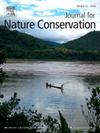IF 2.2
3区 环境科学与生态学
Q2 BIODIVERSITY CONSERVATION
引用次数: 0
摘要
食草动物在生态系统功能中发挥着至关重要的作用,它们通过改变生物和/或非生物成分的物理状态来调节资源的可用性。在中型和/或大型食草动物消失的地区重新引入或重新放养这些食草动物,越来越被视为恢复生态系统过程的关键手段。这些举措通常被称为营养型野化,旨在扭转生物多样性丧失的趋势,恢复生态系统结构,重建营养相互作用。然而,由于营养型野化的生态可持续性、潜在的意外影响以及社会接受度不一,营养型野化仍是一个有争议的概念。虽然有有限的证据支持其在局部范围内的有效性,但仍需要进一步的实证研究来解决这些不确定性。本研究通过对现有框架和案例研究的综合评述,提出了监测营养型野化项目的综合方法。指标分为三类--种群趋势、野化进展和野化影响--兼顾生态和社会经济层面。这些指标旨在确保透明度、可重复性和适应性,从而能够评估生态系统相对于干预前参考状态的长期变化。此外,这些指标还纳入了对当地社区认知和态度的衡量标准,为了解社会接受程度提供了重要依据。如本文所述,实施强有力的监测计划,可以通过生成评估长期有效性的关键数据和解决潜在争议,缓解围绕营养型野化的争议。这种方法提供了一条切实可行的途径,有助于更好地理解和接受营养型野化,同时支持适应性管理和恢复生态系统的完整性。本文章由计算机程序翻译,如有差异,请以英文原文为准。
Socio-ecological indicators for effective monitoring of trophic rewilding with medium/large herbivores
Herbivores play a crucial role in ecosystem functioning, modulating resources availability by altering the physical state of biotic and/or abiotic components. The reintroduction or restocking of medium and/or large herbivores in areas from which they have disappeared is increasingly seen as a key tool to restore ecosystem processes. Often referred to as trophic rewilding, these initiatives aim to reverse biodiversity loss, restore ecosystem structure and re-establish trophic interactions. However, trophic rewilding remains a controversial concept due to concerns about its ecological sustainability, potential unintended effects, and variable social acceptance. While limited evidence exists to support its effectiveness at local scales, further empirical research is needed to address these uncertainties. This study employs an integrative review of existing frameworks and case studies to propose a comprehensive approach for monitoring trophic rewilding projects. Indicators were grouped into three categories —population trends, rewilding progress, and rewilding impacts—balancing ecological and socio-economic dimensions. These indicators are designed to ensure transparency, repeatability, and adaptability, enabling the evaluation of ecosystem changes over time relative to a pre-intervention reference status. Additionally, they incorporate measures of local community perception and attitudes, providing essential insights into social acceptance. The implementation of a robust monitoring program, as outlined here, could mitigate controversies surrounding trophic rewilding by generating critical data to assess long-term effectiveness and addressing potential disputes. This approach offers a practical path toward fostering better understanding and acceptance of trophic rewilding, while supporting adaptive management and the restoration of ecosystem integrity.
求助全文
通过发布文献求助,成功后即可免费获取论文全文。
去求助
来源期刊

Journal for Nature Conservation
环境科学-生态学
CiteScore
3.70
自引率
5.00%
发文量
151
审稿时长
7.9 weeks
期刊介绍:
The Journal for Nature Conservation addresses concepts, methods and techniques for nature conservation. This international and interdisciplinary journal encourages collaboration between scientists and practitioners, including the integration of biodiversity issues with social and economic concepts. Therefore, conceptual, technical and methodological papers, as well as reviews, research papers, and short communications are welcomed from a wide range of disciplines, including theoretical ecology, landscape ecology, restoration ecology, ecological modelling, and others, provided that there is a clear connection and immediate relevance to nature conservation.
Manuscripts without any immediate conservation context, such as inventories, distribution modelling, genetic studies, animal behaviour, plant physiology, will not be considered for this journal; though such data may be useful for conservationists and managers in the future, this is outside of the current scope of the journal.
 求助内容:
求助内容: 应助结果提醒方式:
应助结果提醒方式:


